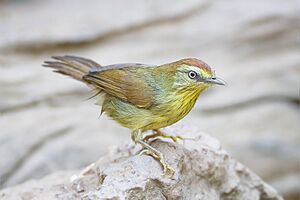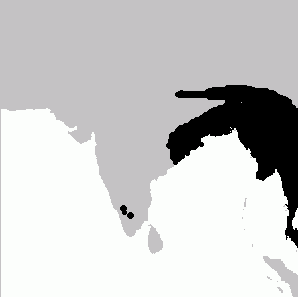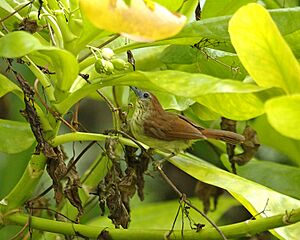Pin-striped tit-babbler facts for kids
Quick facts for kids Pin-striped tit-babbler |
|
|---|---|
 |
|
| Conservation status | |
| Scientific classification | |
| Genus: |
Mixornis
|
| Species: |
gularis
|
 |
|
| Distribution of Mixornis gularis | |
| Synonyms | |
|
Macronus gularis |
|
The pin-striped tit-babbler (Mixornis gularis), also known as the yellow-breasted babbler, is a small bird. It is part of the Old World babbler family. You can find this bird living in South and Southeast Asia.
About the Pin-Striped Tit-Babbler
This bird has a special look. It has a yellowish stripe above its eye, called a supercilium. Its head is a reddish-brown color, which is called rufous. The throat of the bird is yellowish with brown stripes.
You can recognize its call easily. It makes a loud, repeated sound like chonk-chonk-chonk-chonk-chonk. Some people say it sounds a bit like a common tailorbird.
These birds usually move around in small groups. They like to climb and move through low plants and bushes. They build their nests during the pre-monsoon season, from February to July. Their nest is shaped like a loose ball and is made from grasses and leaves.
Naming and Family Tree
The pin-striped tit-babbler was first officially described in 1822. An American scientist named Thomas Horsfield gave it its first scientific name. He studied a bird from Sumatra to do this.
The bird was first placed in a group called Macronus. But in 2019, scientists did a big study using DNA. They found that this bird actually fit better in a different group. So, it was moved to the group Mixornis. This group was first named in 1842 by an English zoologist named Edward Blyth.
The name Mixornis comes from old Ancient Greek words. Mixis means "mixed" or "mingling." Ornis means "bird." The second part of its scientific name, gularis, is a Modern Latin word. It means "-throated."
Scientists have also looked closely at different groups of these birds. They found that the birds living in Borneo and Java look a bit different. Because of this, they were given a new name: the bold-striped tit-babbler (Mixornis bornensis).
Here are the 13 different types, or subspecies, of the pin-striped tit-babbler:
- M. g. rubicapilla (Tickell, 1833) – Found in Nepal, Bhutan, northeast India, Bangladesh, and east-central India.
- M. g. ticehursti Stresemann, 1940 – Lives in west Myanmar.
- M. g. sulphureus (Rippon, 1900) – Found in eastern Myanmar, west Thailand, and southwest Yunnan (south China).
- M. g. lutescens Delacour, 1926 – Lives in southeast Yunnan (south China), north and northeast Thailand, and north Indochina.
- M. g. kinneari Delacour & Jabouille, 1924 – Found in central Vietnam.
- M. g. saraburiensis (Deignan, 1956) – Lives in east-central Thailand and west Cambodia.
- M. g. versuricola Oberholser, 1922 – Found in east Cambodia and south Vietnam.
- M. g. condorensis Robinson, 1921 – Lives on Con Son Island (off south Vietnam).
- M. g. connectens (Kloss, 1918) – Found in Tenasserim (southeast Myanmar), coastal Gulf of Thailand, and central Malay Peninsula.
- M. g. archipelagicus Oberholser, 1922 – Lives in the Mergui Archipelago (off southwest Myanmar).
- M. g. inveteratus Oberholser, 1922 – Found on coastal islands off southeast Thailand and Cambodia.
- M. g. gularis (Horsfield, 1822) – Lives in the south Malay Peninsula, Sumatra, Banyak Islands (west of north Sumatra), and Batu Islands (west of central Sumatra).
- M. g. woodi Sharpe, 1877 – Found in the Palawan group (southwest Philippines).
Where Does It Live?
This bird lives in many places. You can find it in countries like Bangladesh, Bhutan, Brunei, Cambodia, China, India, Indonesia, Laos, Malaysia, Myanmar, Nepal, Philippines, Singapore, Thailand, and Vietnam.
In India, there are some groups of these birds that live far apart from each other. One group was found in southern India by a famous bird expert named Salim Ali. He saw them near the Kabini reservoir. For a long time, no one saw them there again. But in 2004, this southern group was found again in the Masinagudi area of Mudumalai. Other groups of these birds also live in the northern Eastern Ghats in India.



